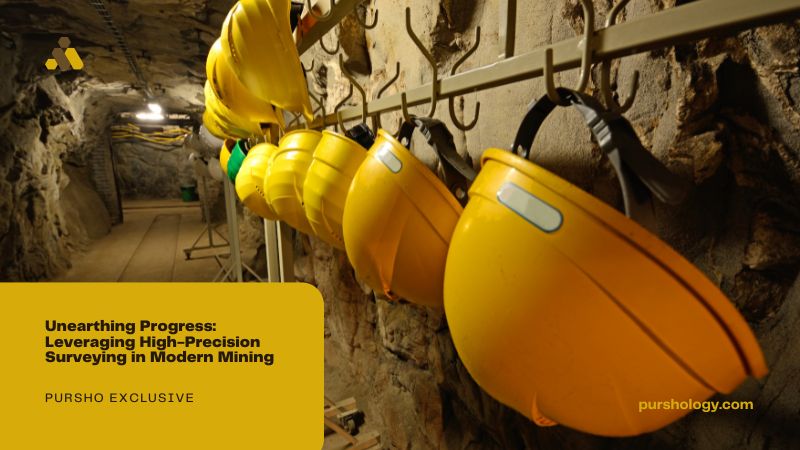Mining operations have long relied on the accurate collection and analysis of spatial data to unlock the potential of mineral resources buried beneath the Earth’s surface. High-precision surveying plays a pivotal role in modern mining, offering a wide array of benefits that enhance safety, efficiency, and environmental responsibility within the industry.
What is the role of high-precision surveying in modern mining?
Importance of accurate spatial data in mining operations
Accurate spatial data is crucial in mining as it facilitates informed decision-making for exploration, mine development, and production activities. By providing precise information on the topography, geology, and structural characteristics of mining sites, high-precision surveying enables miners to optimize resource extraction processes and minimize risks.
Applications of high-precision surveying in mine planning
High-precision surveying is extensively used in mine planning, encompassing activities such as site selection, design of access roads, and determination of optimum pit boundaries. It aids in establishing the most efficient and safe methods of extracting minerals while maintaining the structural integrity of the mining environment.
Benefits of leveraging precision surveying technologies in mining
The utilization of precision surveying technologies in mining confers several advantages, including enhanced operational efficiency, reduced costs through optimized resource utilization, and improved safety protocols. These technologies also facilitate the monitoring and management of environmental impacts associated with mining activities.
How do GNSS modules enhance surveying accuracy in mining?
Understanding the principles of GNSS technology
GNSS (Global Navigation Satellite System) technology utilizes satellite signals to determine the precise location and time information for surveying purposes. In mining, GNSS modules enable accurate positioning and movement tracking, providing real-time data for mine planning, operational control, and safety monitoring.
Advantages of using GNSS modules in mining surveying
By incorporating GNSS GPS modules, mining surveyors can achieve high levels of accuracy and reliability in spatial data collection. These modules enable continuous positioning and monitoring, even in challenging environments, enhancing the overall efficiency and effectiveness of mining operations.
Challenges and limitations of GNSS modules in mining environments
Despite their significant benefits, GNSS modules may face challenges in certain mining environments, such as underground operations or areas with significant signal interference. Overcoming these limitations requires the development of specialized solutions and the integration of complementary surveying technologies.
What are the key considerations for implementing high-precision surveying in mining operations?
Selecting the most suitable surveying equipment for mining activities
Choosing the right surveying equipment is essential for meeting the specific demands of mining operations. Factors such as accuracy, durability, and adaptability to diverse terrains must be carefully evaluated when selecting surveying tools for different stages of mining projects.
Integrating high-precision surveying with mine management systems
The integration of high-precision surveying with mine management systems, including GIS (Geographic Information System) and mine planning software, provides a holistic approach to data analysis and decision-making. Seamless integration enhances the efficiency of mining operations and facilitates real-time collaboration among different departments.
Training and competency requirements for personnel using high-precision surveying tools
Ensuring that personnel possess the necessary skills and knowledge to operate high-precision surveying tools is crucial. Proper training and ongoing education programs contribute to the effective utilization of surveying equipment, ultimately leading to improved safety, accuracy, and productivity within mining operations.
How does high-precision surveying contribute to safety and efficiency in mining?
Enhancing safety protocols through accurate spatial data in mining
Precise spatial data obtained through high-precision surveying supports the implementation of robust safety protocols in mining operations. It enables the identification of potential hazards, monitoring of ground stability, and implementation of effective emergency response plans, thus reducing the risk of accidents and injuries.
Improving operational efficiency and productivity with precision surveying
Efficient utilization of spatial data obtained from high-precision surveying leads to optimized mining processes, streamlined logistics, and improved resource allocation. This, in turn, enhances overall operational efficiency and productivity, contributing to the sustainable growth of mining endeavors.
Mitigating environmental impact through precise surveying and planning
The accurate mapping of geological features and environmental considerations, facilitated by high-precision surveying, supports proactive environmental planning and management in mining. By minimizing disturbances to ecological systems and ensuring responsible resource extraction, precision surveying helps mitigate the environmental impact of mining activities.
Innovations and future trends in high-precision surveying for the mining industry
Emerging technologies and advancements in mining surveying
The mining industry is witnessing the development of advanced surveying technologies, including LiDAR (Light Detection and Ranging) and 3D modeling techniques, which offer enhanced capabilities for site characterization and resource estimation. These innovations are poised to revolutionize the way spatial data is collected and utilized in mining.
Potential impact of AI and machine learning on high-precision surveying in mining
Artificial intelligence (AI) and machine learning applications have the potential to revolutionize high-precision surveying in mining by automating data analysis, pattern recognition, and predictive modeling. This can lead to greater efficiency and accuracy in decision-making processes, paving the way for more sophisticated and adaptive mining operations.
Prospects for further integration of high-precision surveying in mining automation
The integration of high-precision surveying with autonomous mining technologies is poised to drive the next wave of efficiency and safety improvements in the industry. As mining automation continues to evolve, the seamless integration of high-precision spatial data collection and analysis will be pivotal in optimizing autonomous mining processes.




